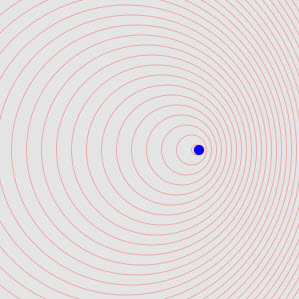I’ve finally written some code that works in IE8.0, chrome and firefox. Rather than drawing complex fractals and solutions to equally archane differential equations, I’m trying to build some simple demos using more easily understood principles and mathematics.
Now this is a very simple model that just shows the general principles of how something like a shockwave can build up from basic building blocks. Before I go into too much description, give it a spin and see if you can figure out what is going on. Try sliding the speed back to zero, then to one and up past one, racing supersonic!
Mach:0.5
I first encoutered the mathematics for this little demo in a beautiful Russian book of mathematics aimed at high school students. It demoed families of curves from physical problems and then used basic calculus to find interesting related curves. It was a trancendent text and it introduced me to the theory of evelopes
Here is what’s going on. Imagine a little super bee sitting on a flower just beating his wings. The sound waves radiate in circles at the speed of sound around him. That’s what you see when you slide the speed down to zero. The waves expand concentricly and uniformly in space.
Now our bee is done colecting polen and starts heading back to the hive at a leisurly pace. At each moment the sound waves still expand in a circle around him, but now that he is moving he’s not at the same place when he emits the next one. Now things are no longer uniform. The waves of pressure are bunching up ahead of him, and spreading out behind.
Now his bee sense starts tingling and he kicks is in gear to get to a disturbance at the hive. He approaches the speed of sound. Now things get interesting as he hits the speed of sound. He still emits sound the same way, but now by the time the next wave is released, he’s caught up with it, and the same with the one right after, and so on. All these waves keep piling up building a huge wave of pressure right on top of him. In this model with non-interacting waves and constant velocity, the pressure wave is infinite. The wave still exists in more realistic models, but things like changes in air pressure, temperature and density put a limit on how much pressure actually builds up.
Just a little more speed, push it, push it, and he’s through. Once he’s moving faster than sound, the waves can’t even catch up, and expand out in a cone behind him perfect to sneak up on wrong doers, as noone can hear him outside of the cone training behind him, and by then it’s too late. POW!
In reality, this just shows where the simple model breaks down. There are many more effects that kick in and become important long before these speeds are reached, however I love how this simple model using nothing more than addition and multiplication can explain some of the features of supersonic travel.

Leave a Reply